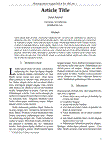| Sumario: | Copepod species of the genera Calanoida, Harpacticoida and Cyclopoida are used in aquaculture as food for marinelarval fish. The calanoids are the most well-known species; most are easily identified as adults and thereforerelatively easy to isolate from the wild. They require phytoplankton as food, and many calanoids are broadcastersshedding their eggs individually. The eggs sink to the bottom, which, when siphoned, removes both eggs and otherdebris. This is usually sufficient to maintain tank hygiene. Many calanoids cannot be kept at high densities andrequire therefore large volumes for their culture. Harpacticoids are generally benthic grazers, can be maintained atvery high densities and therefore in much smaller volumes. They require surface area, which can be provided byplacing structures within a tank, although this may complicate the method for cleaning tanks and maintaining tankhygiene. Harpacticoids do not require phytoplankton and can be fed inert feeds. Both harpacticoids and cyclopoidshave egg sacs and different methods have been developed for harvesting the nauplii from the culture tanks. Theharpacticoids seem particularly difficult to separate from the debris, whereas this seems easier to achieve withcyclopoids nauplii. The cyclopoids, like the harpacticoids, can be maintained in high densities and seem alsorelatively easy to culture.Pond cultures using fertilisers are also used to produce copepods for rearing fish larvae. The fish are either rearedwithin the same system or in separate units. Generally, all 3 genera are represented in the zooplankton blooms. Thedisadvantages of pond cultures include the risk of parasite transfer, no control over species occurrence andabundance, and in temperate climates this type of culture is seasonally restricted.
|
|---|
